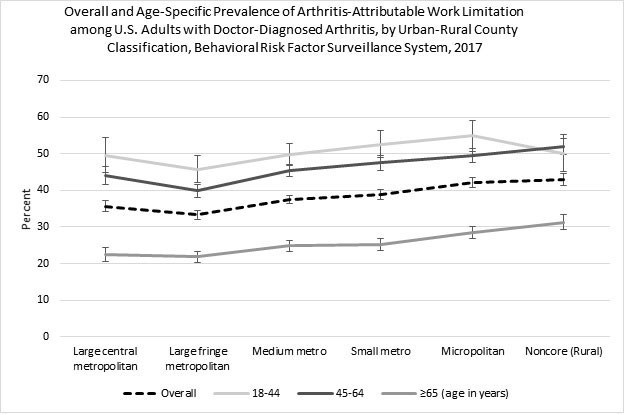Session Information
Date: Tuesday, November 12, 2019
Title: Epidemiology & Public Health Poster III: OA, Gout, & Other Diseases – ARP
Session Type: Poster Session (Tuesday)
Session Time: 9:00AM-11:00AM
Background/Purpose: Arthritis prevalence ranges from 1-in-5 to 1-in-3 across U.S. counties, and its prevalence and effects vary by county economic grouping, metropolitan status, and uneven population density. It is a leading cause of work disability, which research suggests is sometimes linked to specific occupations/industries or job tasks. We examined the prevalence and variation of arthritis-attributable work limitation (AAWL) by overall county classification and selected characteristics.
Methods: Cross-Sectional data were from the 2017 Behavioral Risk Factor Surveillance System, an annual, state-based, random-digit–dialed landline/cellphone health survey of non-institutionalized U.S. adults ≥18 years. Among adults with self-reported, doctor-diagnosed arthritis (145,776 respondents in 50 states and D.C.), AAWL was defined as “yes” to “In this next question, we are referring to work for pay. Do arthritis or joint symptoms now affect whether you work, the type of work you do, or the amount of work you do?” Analyses were restricted to those with AAWL, age, and county data (n=141,183). The National Center for Health Statistics 2013 Urban-Rural Classification Scheme for Counties was used to classify respondents in counties from most-urban to most-rural: large central metropolitan; large fringe metropolitan; medium metropolitan; small metropolitan; micropolitan; and noncore (smallest rural). Age-Specific estimates of AAWL prevalence by urban-rural status and selected characteristics were calculated with 95% confidence intervals (CIs). Pairwise comparisons tests for statistically significant differences between county classifications were conducted at α=0.05.
Results: Overall prevalence of AAWL among adults with arthritis ranged from 36% in large central metropolitan to 43% in the smallest rural (noncore) counties, with considerable variation by age group (Figure). Among 18-44 year olds, AAWL prevalence varied little by county classification, e.g., no statistical differences for less than high school education, unable to work/disabled, or having 0 or 1 comorbid conditions. For those ages 45-64, unemployed respondents in the 3 smallest county classifications reported higher prevalence of AAWL (range: 70-72%) vs the 3 largest county classifications (range: 54-57%). Prevalence of AAWL was highest among those 45-64 unable to work/disabled in noncore (rural) counties (76%) vs the 3 largest county classifications (69.0%, 70.8%, and 71.8%, respectively). AAWL prevalence and significance by county varied for physical activity obesity in this age group. Magnitude of AAWL prevalence was lowest among those ≥65, but all characteristics examined displayed variations by county classification.
Conclusion: Observed variations in AAWL prevalence are not fully understood. Some may be explained by distributions of arthritis-associated industries/occupations in more rural areas (e.g., farming, forestry), demographic shifts, and limited access to health care. Overall, county-specific AAWL prevalence was ≥1-in-3, indicating widespread need for evidence-based interventions to reduce negative personal and societal economic consequences of arthritis.
To cite this abstract in AMA style:
Theis K, Liu Y, Boring M, Souza K. Arthritis-Attributable Work Limitation Variation by U.S. County Classifications and Selected Characteristics, 2017 [abstract]. Arthritis Rheumatol. 2019; 71 (suppl 10). https://acrabstracts.org/abstract/arthritis-attributable-work-limitation-variation-by-u-s-county-classifications-and-selected-characteristics-2017/. Accessed .« Back to 2019 ACR/ARP Annual Meeting
ACR Meeting Abstracts - https://acrabstracts.org/abstract/arthritis-attributable-work-limitation-variation-by-u-s-county-classifications-and-selected-characteristics-2017/

